How to Care for a Christmas Cactus: 10 Tricks & Tips
-

- Last updated:
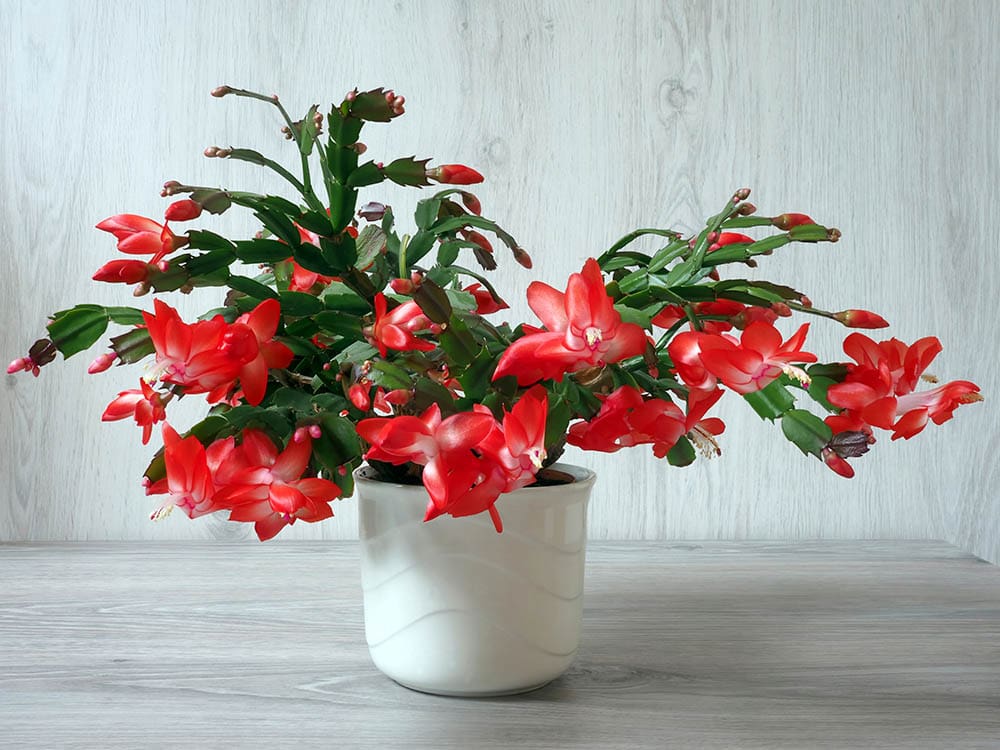
With its spritely pops of color at year’s end, the tropical Christmas cactus offers some much-needed warmth in the otherwise dull, cold winter. When most plants have gone dormant, it shines as a notable holiday highlight, producing floral explosions of reds, oranges, purples, and whites.
While they’re easy to propagate and grow, Christmas cacti require particular care if you want the best wintertime blooms. To help you get the most dazzling display possible, we’ve put together this handy list of 10 tricks and tips for taking care of a Christmas cactus.
The 10 Tricks & Tipson How to Care for a Christmas Cactus
1. Propagate a Christmas Cactus from a Stem Cutting
You can propagate a Christmas cactus without much fuss by taking cuttings consisting of 3–4 segments from the end of a healthy plant. Take the cuttings in late spring when the blooming period has passed, and new growth has begun. Store the cuttings in a cool, dry place for a few days to allow the ends to dry out.
Fill a small pot with a sand and peat moss mixture. Cuttings should sit about ½ inch to 1 inch below the soil. Three or four cuttings can fit into a single container 4–6 inches wide.
Keep the soil moist and place the pot in a bright area away from direct sunlight. Wrap a clear plastic bag around the cactus and pot, and secure it with a rubber band after watering to provide a humid environment.
The cuttings will develop roots in about 2–3 weeks, at which point you can do away with the bag. Transplant the cuttings to a larger pot with the appropriate soil mixture in another 5–6 weeks when the roots are at least half an inch long.
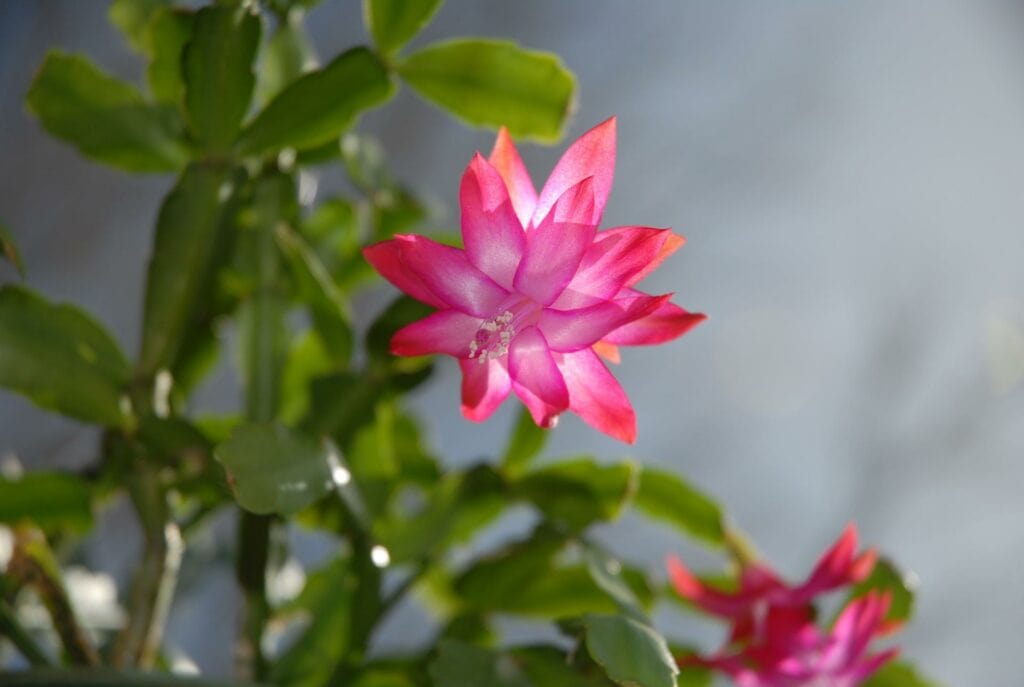
2. Use a Breathable Pot
Christmas cacti need much more water than their desert-dwelling counterparts, but they can’t stand sitting in waterlogged soil because it may lead to root rot and fungal attacks. Plant your Christmas cactus in a pot with drainage at the bottom. Rather than use a plastic container, opt for a breathable terra cotta, clay, or ceramic variety to help wick moisture from the soil.
The container doesn’t need to be too large because the Christmas cactus grows well with crowded roots. A pot 4–5 inches wide for a few baby cuttings is sufficient to start, keeping in mind that you’ll be repotting in a few weeks and then every few years after.
To take full advantage of your Christmas cactus, plant it in a hanging pot or place it on a wide surface so it can cascade freely. No matter where you put it, make sure the drip tray underneath is easy to access and remove, as you may need to drain it frequently.
3. Use a Rich, Well-Drained Soil
While the Christmas cactus is generally tolerant of varying soil conditions, the most crucial aspect is drainage. Loamy, sandy soil is ideal. Use a cactus or succulent mix or potting soil mixed with sand and compost. It should have a 5.5–6.2 pH level, achievable through a sphagnum peat moss amendment as needed.
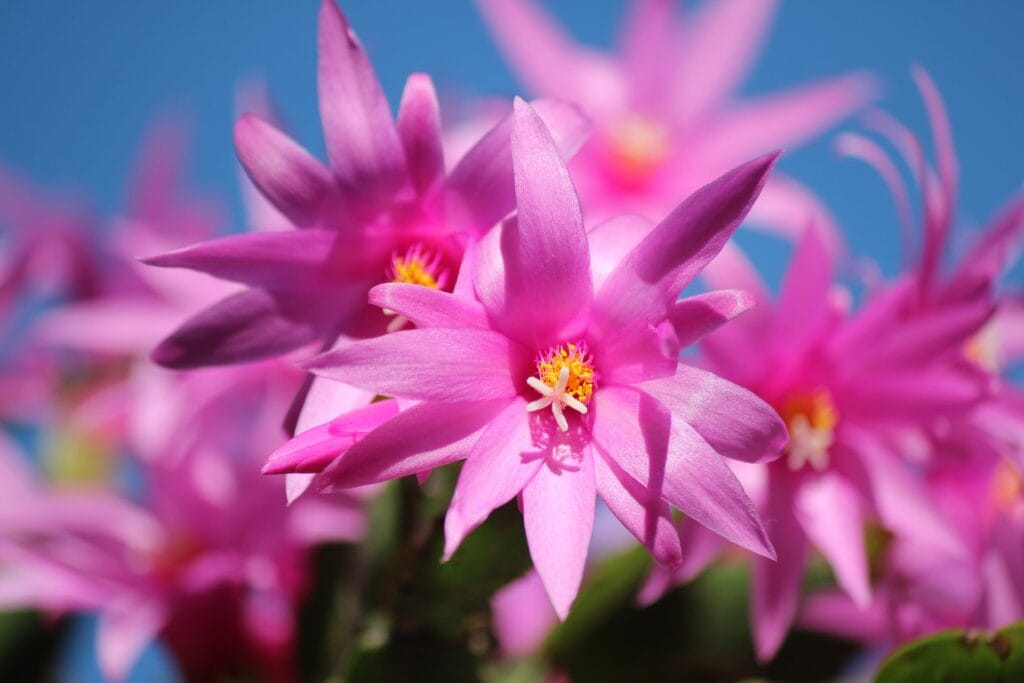
4. Give It Lots of Light
While it can survive in low light, the best Christmas cactus blooms and growth happen under bright light. With that in mind, avoid giving it too much direct sunlight, as the leaves easily burn and bleach. Position it in an east-facing window for partial or diffused sunlight.
5. Check Water Levels Weekly
Christmas cacti need consistent water, but you can’t let them develop wet feet. The removable tray at the bottom of the pot is helpful after watering to prevent the roots from flooding. Water the plant, then wait about 15 minutes and empty the excess water collected in the bottom of the pot.
Water needs will vary through the year. Hot summer days may require you to water the cactus 2–3 times weekly, while the winter often lets you cut back to once every 1–2 weeks. The soil has to dry out a little between waterings. When the top third (the first 2 inches or so) feels dry, you can add more water. The plant typically shows it needs water in puckered, shriveled, or wilting leaves.
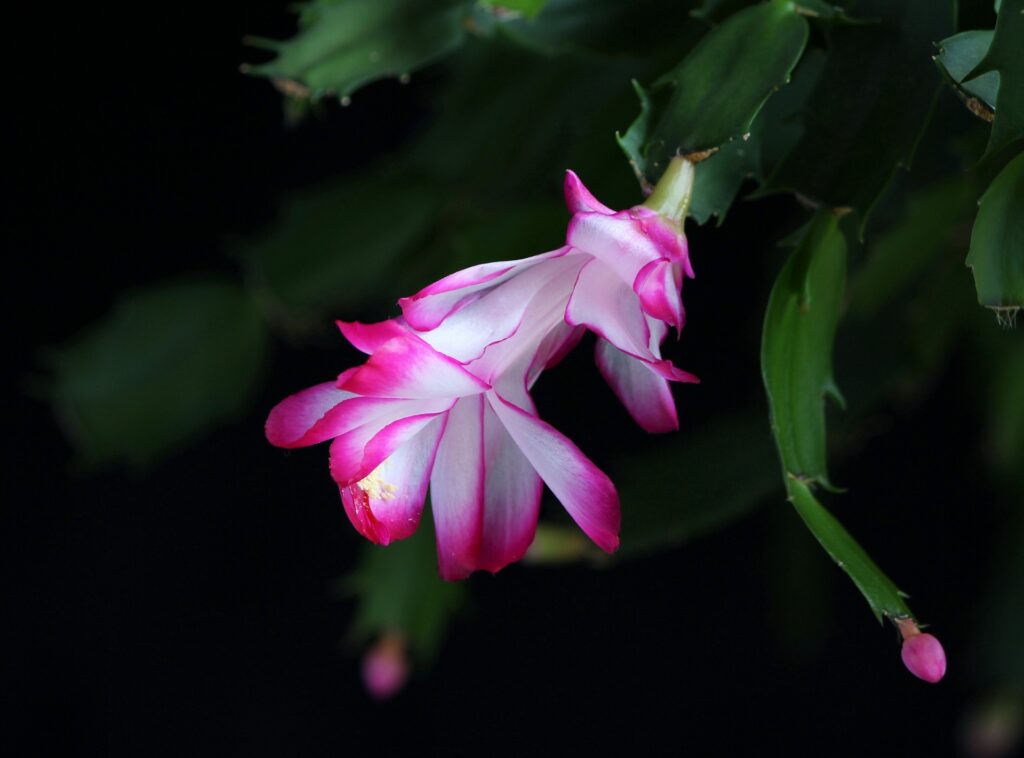
6. Provide a Humid, Room Temperature Environment
As a rainforest dweller, the Christmas cactus loves high humidity, if not extra-moist soil. It grows best when humidity is around 50–60%, which doesn’t always align with personal comfort. If the room is dry, place a water-filled tray of pebbles under your container, making sure not to let the water touch the pot. Alternatively, you can mist your plants 2–3 times weekly.
The ideal temperature range for summertime growth is between 65°F and 75°F. Evening temperatures should be about 10 degrees cooler, hovering around 55°F to 65°F. If the climate permits, feel free to move the cactus outdoors to a shady spot in the summer. Move them back inside when the temperatures begin to dip below 50°F.
7. Add Fertilizer Frequently
A balanced houseplant fertilizer is an excellent amendment to help with healthy wintertime blooms. Start adding a 20-20-20 water-soluble fertilizer diluted to half-strength when the plant has taken root at roughly three weeks old.
Use fertilizer on your Christmas cactus after the flowering period, applying it monthly from spring through summer. To promote flowering, stop adding fertilizer in late fall, about a month before buds begin emerging. You can resume adding fertilizer once every 4–6 weeks when the plant blooms.
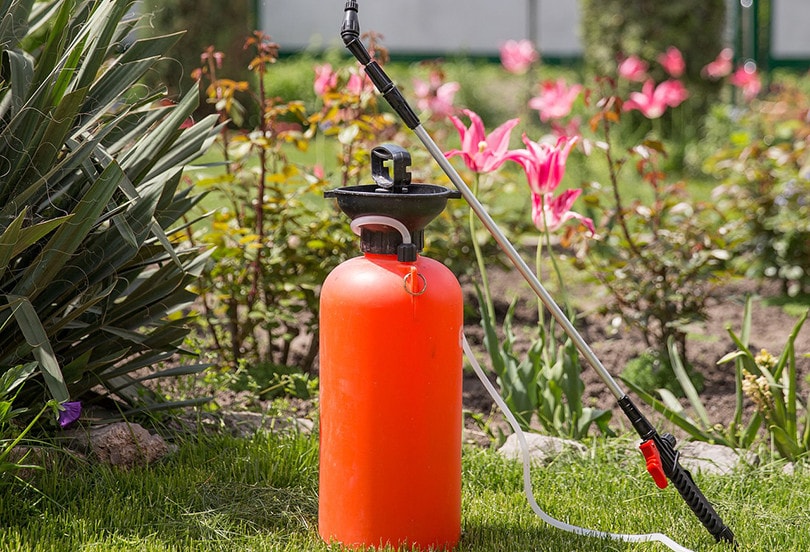
8. Adjust, Watering, Lighting, and Temperature to Trigger Blooming
Upkeep for your Christmas cactus is simple from spring through fall, but you must change your habits around October as the plant gears up for flowers. Cool days and long nights prompt blooming, and you can maximize growth by adjusting the indoor environment accordingly.
Forcing your Christmas cactus into dormancy can stimulate better blooming. Stop watering around the time you stop fertilizing in October. Keep it humid or lightly watered if the soil feels particularly dry.
You must lower the temperature and adjust lighting for roughly six weeks before blooming so that the buds will set. Drop the temperature to 50°F–60°F, and adjust the lighting to include 12–14 hours of total darkness. If you can’t keep your plants cooler than 55°F, give it an extra hour or two without light. Keep plants away from all artificial and natural light during the dark hours. Place them in bright indirect sunlight for the other 10 hours of the day.
Be consistent with watering, ensuring the Christmas cactus doesn’t dry out or become overwatered and lose buds. Start increasing moisture, temperature, and light when the buds begin forming.
9. Repot Every 2–3 Years
Because it prefers being rootbound, you won’t have to repot your Christmas cactus each year. Change containers every 3–4 years instead, or refresh them when the plant looks damaged and in need of clean soil.
Change containers in February or March when the plants are no longer in bloom. Add fresh potting soil to a new pot 2–3 inches larger than the current one. Carefully remove the cactus from its pot, gently loosening the root ball as you pull the entire plant from the soil. Set it in the new pot with the roots roughly an inch beneath the soil’s surface.
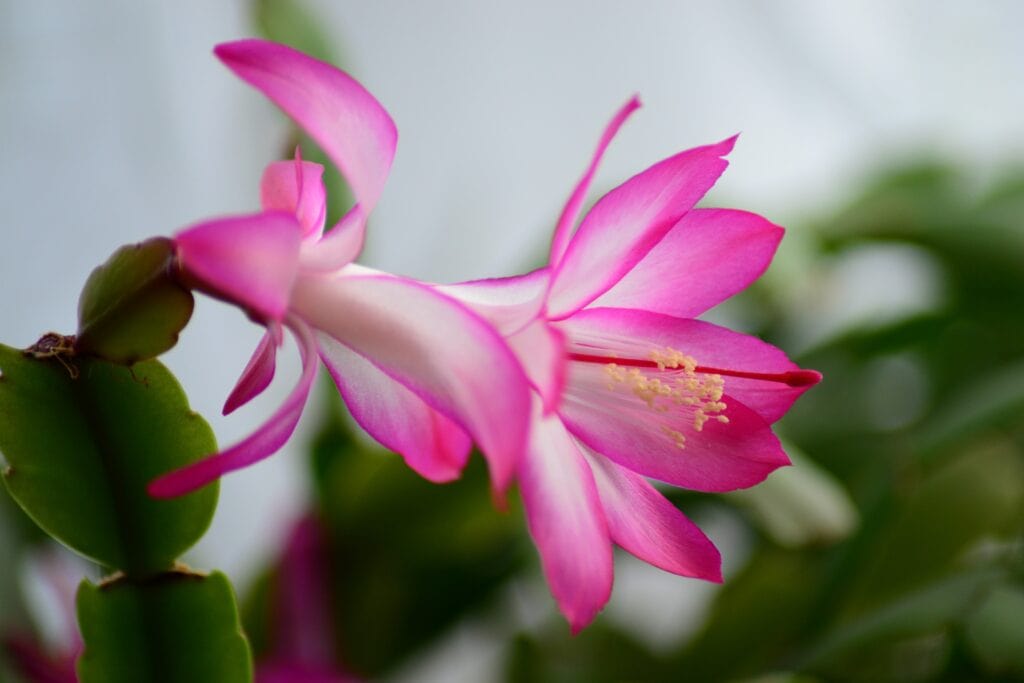
10. Prune Annually As Needed
Pruning your Christmas cactus can encourage more branches and, subsequently, more blossoms as it grows. The plant enters its new growth stage following its blooming period. Stop watering the plant for 30 days after blooming and give it time to rest. You can then start pruning and propagating up through late spring.
You don’t need to prune the Christmas cactus too much, but removing any withered or uncontrolled growth is always a good idea. Twist the plant where two segments meet or use a sharp blade to sever the connection. Cut 2–3 segments from each branch, making sure to trim only one-third of the plant or less.
Final Thoughts
Random pests like thrips, mealybugs, and scale may be occasional concerns. But in general, proper maintenance helps the Christmas cactus take care of itself. The crucial concerns are keeping it well-watered and giving it the appropriate amount of sunlight.
It can seem like a lot to remember when you’re getting started, and you shouldn’t be disheartened if you see a few buds drop in the first season. With these tips and tricks for caring for a Christmas cactus, you’ll discover that it can be extra easy to delight in one of nature’s most spectacular wintertime displays.
Featured Image Credit: Burkhard Trautsch, Shutterstock
Contents

